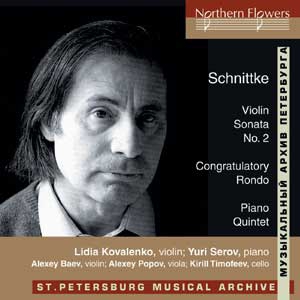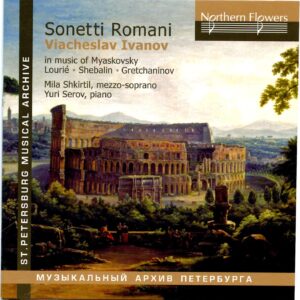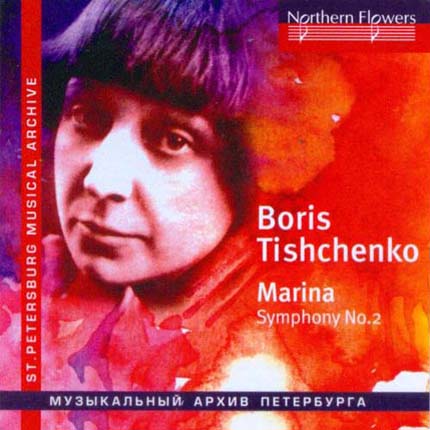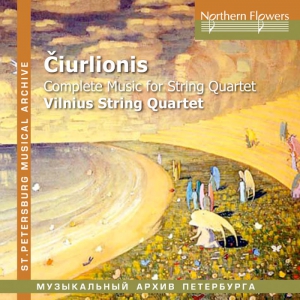Description
Recorded at the St. Catherine Lutheran Church, St. Petersburg, April 24 & July 18, 2001
Sound recording & supervision: Victor Dinov
Editing: Victor Dinov
English translation: Sergey Suslov
Design: Anastasia Evmenova & Oleg Fakhrutdinov
| Alfred Schnittke (1934–1998) | ||
| 1. | Sonata No. 2 for violin and piano. Quasi una Sonata (1968) | 20.33 |
| 2. | Congratulatory Rondo (1973) |
8.34 |
| Piano Quintet (1972–1976) | ||
| 3. | Moderato |
5.40 |
| 4. | Tempo di valse |
5.28 |
| 5. | Andante |
6.01 |
| 6. | Lento |
3.51 |
| 7. | Moderato pastorale |
3.19 |
| Lidia Kovalenko,, violin (1 – 7) Yuri Serov, piano (1 – 7) Alexey Baev, violin (3 – 7) Alexey Popov, viola (3 – 7) Kirill Timofeev, cello (3 – 7) |
||
| Recorded at the St. Catherine Lutheran Church, St. Petersburg, April 24 & July 18, 2001 Sound recording & supervision: Victor Dinov Editing: Victor Dinov English translation: Sergey Suslov Design: Anastasia Evmenova & Oleg Fakhrutdinov Today, it is not doubted any more that Alfred Schnittke has become one of the most important composers of the 20th century, his music deeply and vividly reflecting complicated cultural processes of our times. In the contradictory and kaleidoscopic style environment of the second half of the last century, Schnittke found his own inimitable way of continuous development, search, and discovery. Deep personal feeling, the scope of goals set, search for answers to crucial questions of our existence, striking convincing power, and technical perfection of most mature works of the composer have attracted more than one generation of music lovers worldwide, making them listen and think. Alfred Schnittke said once that art always begins in man and ends in man (“Attitude to man is important, not the style”.) The works presented in this program illustrate this most relevantly.
The Second Violin Sonata by Alfred Schnittke begins with an abrupt piano chord, like a rifle shot. It blows up the silence and the very notion of the style, established in many centuries. It is the start of the Polystylistics era in the works of Schnittke, and moreover, for the Soviet music in general. The subtitle given by the composer to his work is “quasi una Sonata”, echoing Beethoven’s eternal “Moonlight Sonata”, Sonata quasi una Fantasia. Beethoven in his masterpiece steps out into the domain of the Romantic music, being unable to stay within a classical sonata’s framework. Schnittke, on the contrary, is annoyed with the sonata form as such. The contradictions and contrasts are too strong, and just the startling freedom of utterance should lay a foundation for setting up something new.
The world of harmony and disharmony, unbearable noise of sounds and silence in its pre-existent definition, episodes of hard rhythm and anarchy of tempos such are the basic “construction materials” of this astonishing, unexampled sonata. But there is another important aspect, that of relations between Person and Society, the lone voice of man and the powerful roar of crowd; of confusion, perplexity, fear, and submission of an individual before the eternal and irresolvable problems of mankind. Allusions of music of the past Beethoven, Brahms, Liszt, and the monogram motif B-A-C-H so cherished by the composer (a tribute to the heritage of the great Bach, the axis and primal source of the musical Universe for Schnittke) bind the work as if with cement, gathering a consolidated chain of positive events in a chaos of contradictions. These events offer hope for advent of a new form, a new style, in which the sonata and the quasi sonata will be able to coexist one day.
The Second Sonata by Alfred Schnittke, despite considerable difficulties faced by both performers and listeners, became one of the most repertoire-attractive violin sonatas of the twentieth century. Without uttering a word, the composer in fact tells a great many things in this work, so exceedingly complex in its musical embodiment and language. The established ideals fall into pieces under the troubles of today’s world, the quietude of days of old can never be regained; different, and sometimes painful, efforts are needed to create a new harmony and a new equilibrium.
Congratulatory Rondo was written in 1973 for the 50th birthday of Rostislav Dubinsky, fist violin of the famous Borodin Quartet. The piece styled as a Viennese classic strikes you as something belonging to quite a different epoch. Is it Mozart? Or some violin sonata finale by Schubert that we have forgotten? One year before, Schnittke had already tried his ability in musical “disguise”: his Ancient Style Suite for violin and piano (cembalo) also disappoints the audience with a surprisingly fresh attitude towards classics. Of course, the composer impersonates ‘ancientry’, making an excellent stylization and obviously happy to assume the similitude of a master of the late 18th or early 19th century. But it is also a beautiful message of love to the bygone era, confessing that Beauty and Harmony will never come back again in their initial and pure state as they were embodied by great artists of the past.
The composing mastery of Schnittke seems to have no bounds. The ease with which he sets off traveling across classical modulations (some of them still sound too unexpected for a trained ear, thus betraying the true origin of the piece); the transparent texture of the composition; perfectly neat and refined passages of the violin and the piano part, and elegant play of dynamic tints offer pleasure to both listeners and performers. This tiny ‘occasional’ piece, a kind of musical offering to a friend conceals a vast diversity of ‘details’ of style and meaning, enriching our audible world and extending the bounds of our idea of present-day art.
Quintet for Piano, Two Violins, Viola, and Cello is among the most important works of Alfred Schnittke. The quintet dedicated to the memory of the composer’s mother who died in 1972 was long and difficult to accomplish; it took nearly four years, with intermissions. “I tried to build something shapely, where everything would be carefully balanced and measured. I kept on failing. Finally, I put all the versions aside and started to compose. It looked as if I was learning to walk, from one note to another. I had to almost grope my way … Finally I got a piece that is steady enough in its dynamics and tempos. The music is mostly soft and slow. The five parts of the cycle follow without a pause and almost do not contrast each other in their material.” This is how the composer himself commented on his writing the piece.
The first theme opening the quintet becomes also the leading motif of the entire piece. It resembles an “embryo”, out of which a five-part composition is developing; it may ‘shrink’ to unbelievably ‘close’ quarter-note intervals with the strings, or it may fill the entire sound space with piano clusters.
The 2nd movement is a sad waltz, the core of which is the B-A-C-H motif, already known to us and extremely important for Schnittke. Mournful and soft when first introduced, the waltz is rapidly developing to reach gigantic volumes in the end. The third and the fourth part follow without any interval. No dividing line is noticeable between them. Feelings break loose, the loss is felt as unbearable with a piercing strength. Illumination comes in the finale, all unexpected. The piano theme, clear, major, resembling a pastorale or a countryside strumming, is repeated endlessly remaining the same, while the strings play all the main musical themes of the quintet. The effect is nearly cinematographic, it is visible. The finale’s music is harmonious and beautiful. Nightmares and raving visions retreat, they are not so terrible any more. Death cannot be conquered, but the finale’s main theme, fading away, as if leaving for eternity, reconciles us to its unavoidable advent.
|





